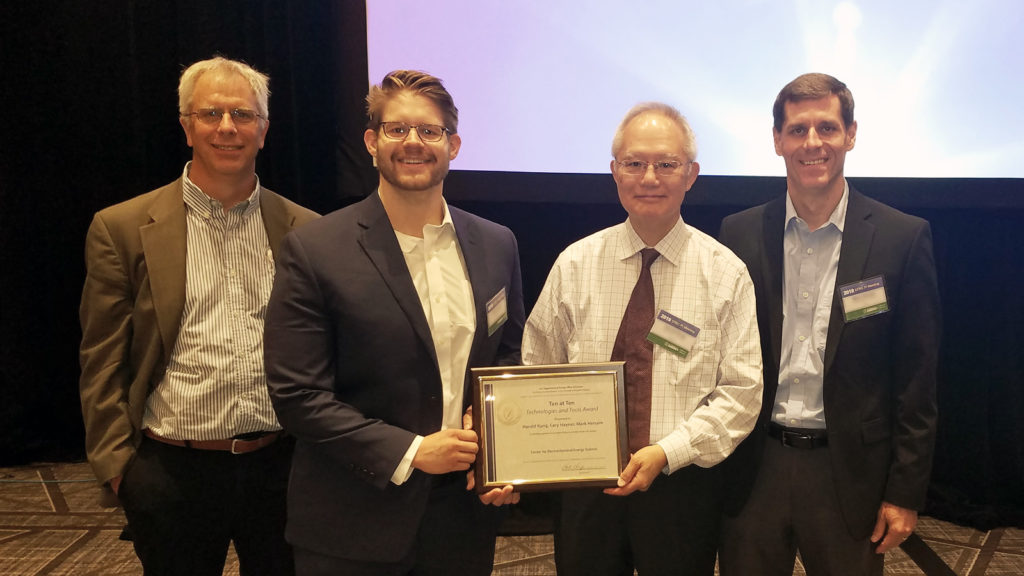This year marks the tenth anniversary of the U.S. Department of Energy’s (DOE’s) Energy Frontier Research Centers (EFRCs). The DOE Office of Basic Energy Sciences launched forty-six such centers in 2009 to bring together teams of scientists to perform basic research beyond what is possible for individuals or small groups. To celebrate the ten-year milestone, DOE selected ten awardees to recognize their having made a major impact on scientific ideas, technologies and tools, and people. Hence, the award name is “Ten at Ten.”
“This award is the consequence of the long-range vision, established at the very start of CEES in 2009, that a robust fundamental understanding of the electrode processes in lithium-ion batteries would have broad benefits.” — Paul Fenter, CEES director
One of the Ten at Ten Awards has gone to three researchers in the Center for Electrochemical Energy Science (CEES), a multi-organizational EFRC led by Argonne National Laboratory in partnership with Northwestern University, University of Illinois and Purdue University. The CEES mission is to explore the fundamental chemistry and materials underlying batteries and energy storage by means of state-of-the-art materials synthesis and characterization.
“This award is the consequence of the long-range vision, established at the very start of CEES in 2009, that a robust fundamental understanding of the electrode processes in lithium-ion batteries would have broad benefits,” said Paul Fenter, CEES director and senior physicist in the Chemical Sciences and Engineering division. Such batteries could power electric vehicles and drones as well as provide energy storage for the grid.
The Ten at Ten Award recipients are two former CEES members, Harold Kung and Cary Hayner, and a current CEES member, Mark Hersam. Both Kung and Hersam are professors at Northwestern University, and Hayner is chief technical officer and co-founder of NanoGraf Corp. (formerly SiNode Systems).
“The interdisciplinary collaborative environment within CEES provides a breeding ground not only for fundamental discoveries but also for disruptive thinking that spawns new technologies,” said Hersam. “The EFRC program is a poignant example of how government investment in research ultimately fuels the innovation that underlies economic growth.”
The Ten at Ten Award recognizes two new electrode technologies for next-generation lithium-ion batteries that were developed based on research that was initiated in CEES. Both technologies use “graphene,” carbon layers just one atom thick, to coat the active materials within the battery electrode to create a “composite” electrode structure. The first advance by Hayner and Kung used graphene in the battery anode, encapsulating particles of silicon. The second advance by Hersam incorporated graphene in the cathode, to encapsulate manganese-based oxides.
The resulting electrodes consist of graphene-coated active materials that have substantially improved properties, such as increased battery power, lifetime, and safety, as well as diminished likelihood of safety problems such as a violent reaction.
Another important feature of these technologies is that they enable lithium-ion batteries to function at temperatures well below the freezing point — a capability critical for electric car owners in cold regions.
“CEES is especially proud that the award-winning research has given birth to two startups,” noted Fenter. A startup company co-founded by Kung and Hayner in 2012 (NanoGraf) is commercializing the graphene-based silicon anode, while a startup company co-founded by Hersam in 2018 (Volexion) is bringing the graphene-based cathode to market.
“We owe our entire existence as a company to the research and people who are part of CEES,” said NanoGraf co-founder Hayner. “The transformative discoveries made by CEES scientists has enabled us to further develop these technologies and bring them to the market to drive a cleaner, more sustainable future.”
The award presentation took place on July 29 in Washington, DC.
The Center for Electrochemical Energy Science is an Energy Frontier Research Center funded by the U.S. Department of Energy, Office of Science, Basic Energy Sciences.
Argonne National Laboratory seeks solutions to pressing national problems in science and technology. The nation’s first national laboratory, Argonne conducts leading-edge basic and applied scientific research in virtually every scientific discipline. Argonne researchers work closely with researchers from hundreds of companies, universities, and federal, state and municipal agencies to help them solve their specific problems, advance America’s scientific leadership and prepare the nation for a better future. With employees from more than 60 nations, Argonne is managed by UChicago Argonne, LLC for the U.S. Department of Energy’s Office of Science.
The U.S. Department of Energy’s Office of Science is the single largest supporter of basic research in the physical sciences in the United States and is working to address some of the most pressing challenges of our time. For more information, visit https://energy.gov/science.



